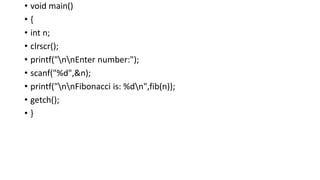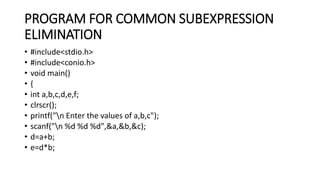The document discusses code optimization techniques including constant folding, copy propagation, and common subexpression elimination. It provides examples of code before and after applying these optimizations. Constant folding replaces expressions with known constant values. Copy propagation replaces variable uses with the variable's assignment. Common subexpression elimination computes shared subexpressions only once. Together these optimizations can improve code efficiency.
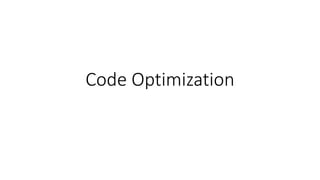

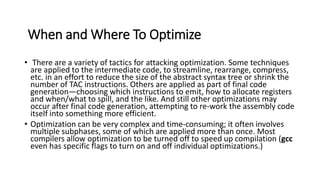

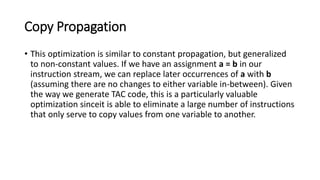
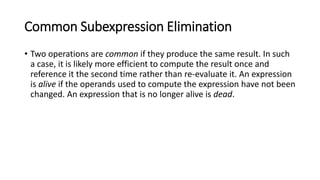
![PROGRAM FOR CONSTANT FOLDING
• #include<stdio.h>
• #include<conio.h>
• int fib(int base)
• {int result,tmp0,tmp1,tmp2,temp[12],f0,f1,i;
• temp[0]=1;
• temp[4]=0;
• temp[1]=base < temp[0];
• temp[2]=base==temp[0];
• temp[3]=temp[1]||temp[2];](https://image.slidesharecdn.com/codeoptimization-141010202452-conversion-gate01/85/sCode-optimization-7-320.jpg)
![• if(temp[3]==temp[4])
• goto L0;
• result=base;
• goto L1;
• L0:
• temp[4]=0;
• f0=temp[4];
• tmp0=f0;
• temp[5]=1;
• f1=temp[5];
• tmp1=f1;
• printf("%d %d ",f0,f1);](https://image.slidesharecdn.com/codeoptimization-141010202452-conversion-gate01/85/sCode-optimization-8-320.jpg)
![• temp[6]=2;
• i=temp[6];
• tmp2=i;
• L2:
• temp[7]=i<base;
• temp[8]=i==base;
• temp[9]=temp[7]||temp[8];
• if(temp[4]==temp[9])
• goto L3;](https://image.slidesharecdn.com/codeoptimization-141010202452-conversion-gate01/85/sCode-optimization-9-320.jpg)
![• temp[10]=tmp0+tmp1;
• result=temp[10];
• printf("%d ",result);
• tmp0=tmp1;
• tmp1=result;
• temp[11]=1;
• temp[12]=tmp2+temp[11];
• tmp2=temp[12];
• goto L2;
• L3:
• L1:
• return result;
• }
• void main()
• {
• int n;
• clrscr();
• printf("nEnter a number:");
• scanf("%d",&n) ;
• printf("nnfibonacci is %d",fib(n));
• getch();
• }](https://image.slidesharecdn.com/codeoptimization-141010202452-conversion-gate01/85/sCode-optimization-10-320.jpg)


